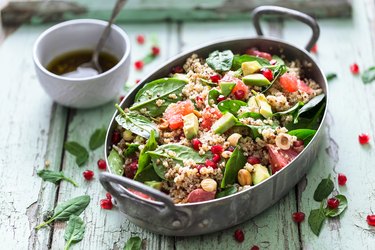
Amino acids build proteins, and proteins are life-sustaining macronutrients. Yet simply calling amino acids the building blocks of protein doesn't do justice to their value. While some amino acids only make proteins, others fill a variety of roles, from supporting metabolism to protecting your heart. Your body can also use amino acids for energy when you lack carbs and fats.
Tip
Amino acids perform a variety of functions in your body, including building protein, serving as a source of energy and making important neurotransmitters that help deliver messages to your brain.
Video of the Day
Build Protein
When cells need protein, they follow instructions from DNA that define the specific amino acids and the order in which they must connect to build the protein. DNA depends on another macromolecule — RNA — to make the protein. RNA takes a copy of the code from your DNA, leaves the cell, finds the amino acids and brings them back to the cell, where they bind into a chain. Each amino acid must be available at the time it's needed or the protein won't be synthesized. When the chain is complete, it twists and folds into a specialized shape. The chemical structure of each amino acid controls the final shape, and the shape determines the function of the protein.
Video of the Day
Synthesize Neurotransmitters
Several amino acids produce neurotransmitters, but two well-known examples are the amino acids tryptophan and tyrosine. Tryptophan produces serotonin, which regulates your moods and makes the hormone melatonin. Tyrosine is used to synthesize norepinephrine and adrenalin. Tryptophan and tyrosine compete with each other for access to your brain. When you eat a lot of carbs, more tryptophan gets into your brain and makes you sleepy. A meal high in protein increases the amount of tyrosine in your brain, which gives you more energy, according to the Franklin Institute.
Protect Cardiovascular Health
Your body uses the amino acid arginine to make nitric oxide. Nitric oxide helps lower blood pressure by relaxing muscles in your blood vessels. It's produced in heart muscles, where it regulates contractions. It may also prevent atherosclerosis by inhibiting the development of plaque in your arteries. Nitric oxide is the active ingredient in nitroglycerin, a medication used to relieve angina, or chest pain caused by coronary heart disease.
Metabolism and Other Roles
Your body prefers to use carbs and fats for energy, but when necessary, amino acids are metabolized for energy. Three amino acids — glutamic acid, cysteine and glycine — combine to form glutathione, which is an antioxidant. The amino acid histidine makes enzymes used to produce red blood cells and maintain healthy nerves. Tyrosine is needed to synthesize thyroid hormones, while methionine makes SAMe, or S-adenosylmethionine. SAMe is essential for the metabolism of DNA and neurotransmitters.
Recommendations and Sources
Your body can make 11 of the amino acids it needs. The other nine must come from your diet. Foods that contain a specific amount of all nine are called complete proteins. Animal products, soybeans and quinoa contain complete protein. Most plant-based foods lack a sufficient amount of one or more of the nine amino acids. What one food lacks, you'll get from another one if you eat a variety of foods and consume the recommended dietary allowance of protein: 46 grams daily for women and 56 grams for men.
- Arizona State University: DNA, RNA and Protein Synthesis
- National Institute of General Medical Sciences: Proteins Are the Body’s Worker Molecules
- Colorado State University: Adrenal Medullary Hormones
- National Center for Biotechnology Information: Amino Acids Are Precursors of Many Biomolecules
- Franklin Institute: Protein and Amino Acids
- World of Molecules: Histidine
- Oklahoma Cooperative Extension Service: Protein and the Body
- University of North Dakota: Protein